12 October, 2006
New NEMA EIA Regulations workshops ...
The intention of the two-day training workshop is to provide clarity on issues and/or concerns regarding the new NEMA Regulations and how they will be implemented in the Western Cape.
The target audiences for these workshops include municipalities (in particular, Councilors, Town & Regional Planners, Technical Services Engineers, Environmental staff and Project Managers), government departments, consultants, business and industry and members of public.
There will be a series of workshops throughout the Western Cape. However, the workshop that falls within your area will be held at the location as set out below:
Karoo (Prince Albert) 19-20 October (RSVP 12 October )
Overberg (Caledon) 31 October & 1 November (RSVP 23 October)
Cape Town 6-7 November (RSVP 30 October)
Boland (Stellenbosch) 8-9 November (RSVP 1 November)
South Coast (George) 13-14 November (RSVP 6 November)
West Coast (Piketberg) 16-17 November (RSVP 9 November)
Please ensure that you register before the RSVP date, by replying to the contact details as set out below, so that the necessary catering and logistical arrangements can be made.
Strategic Environmental Focus (Pty) Ltd
P. O. Box 1330
Durbanville
7551
Tel: (021) 979 3822
Fax: (021) 979 3830
E-mail: Victoria@sefsa.co.za
You are urged to make use of this opportunity to gain a greater understanding of the new environmental regulations.
Draft Off-Road Route Guidelines ...
Draft Off-Road Route Guidelines that are now available for public review.
A detailed letter about the whole guideline process is available from the contact person detailed at the end of this post.
Unfortunately these document are too large to send as attachments, and you are requested to download them from either www.savannahSA.com or www.capegateway.gov.za/eadp
I have downloaded them on my dial-up system and it took a total of 18 minutes to download all three documents. I recommend that you 'right-click' on "View" and use "Save Target As" - this should facilitate the download process.
The files are as follows:
* Planning and Managing Sustainable Off-Road Routes: A Guide for Route Planners and Operators - 3,196kb
* Assessment and Evaluation of proposed and existing Off-Road Routes: A Guide for Environmental Assessment Practitioners and Authorities, and Route Planners - 1,968kb
* Environmental Ethics and Sustainable Use of Off-Road Routes and Trails: A Practical Guide for Recreational Trail Users - 133kb
The letter also includes details of two public meetings that will be held to discuss comments regarding the guidelines.
They are as follows:
a.. Cape Town - Wednesday 25th October, 9.30am, Kirstenbosch Stone Cottages (2-3 hours as needed)
b.. George - Thursday 26th October, 10.30am, King George Protea Hotel (2-3 hours as needed)
Contact:
Please reply to Kathy Leslie, wleslie@iafrica.com if you are able to attend
either meeting. Any other comments or queries can be forwarded to Kathy or
Karen Jodas of Savannah Environmental by 9th November 2006.
Kathy Leslie 083 325 5615 or 021 671 9350 (fax 088 021 671 9350)
All ISO certified companies - capacity building opportunity ...
You are invited to attend this highly informative workshop to be held at the Koeberg Visitors Centre in Koeberg on 26th October 2006. The programme is designed to inform on a range of important topics which currently challenge industry and are of particular importance to those who manufacture, fill, use, empty, dispose, reprocess or recycle industrial packaging and especially those who have ISO certification to keep them up to date with new legislation and best global industry practice.
Speakers include Provincial Government on the Green Scorpions approach to compliance, monitoring and enforcement and new Waste legislation, SANAS on what SANAS Accreditation means and why it is important to your certification body to several innovative ways for recycle of common waste streams including ewaste as well as feedback from the recent International Industrial Packaging Conference in San Francisco.
Secure your place by completing and returning the attached registration form by fax 032-942 8328 or email liz@rcmasa.org.za and do pass on a copy to anyone you know who should attend.
For more information on this stunning venue, please visit the Eskom Website on www.eskom.co.za.
Look forward to seeing you on the 26th.
Best regards, Liz and Lee-Anne
PO Box 894
Umhlali
4390
liz@rcmasa.org.za
tel: 032-942 8256
fax: 032-942 8328
Wetland service provider required ...
SANBI is acting as the national focal point for a project on the
sustainable management of inland wetlands in southern Africa, funded
by the Global Environment Facility and implemented through International
Water Management Institute, IUCN and Food and Agriculture Organisation.
IUCN Regional Office for Southern Africa, which is responsible for the
component of the project dealing with assessment of needs for capacity
development, would like to appoint a service provider to undertake a
short study on policies, strategies, curricula and institutional
arrangements for wetland management in South Africa. A ToR is available for more information.
Anyone interested in undertaking this work should submit to me the CVs
of a proposed two person team before 18 October 2006.
Please note that the budget for this work is fixed and is included in
the ToR, so it is implicit that you will need to scale the intensity
of the study to fit the funds available.
Contact person:
John Dini
Programme Manager
Working for Wetlands
South African National Biodiversity Institute
Private Bag X101, Pretoria, 0001
South Africa
Tel: +27 12 843 5292
Fax: +27 12 843 5205
Cell: 083 420 7988
Email: dini@sanbi.org
www.sanbi.org
24 September, 2006
Global ocean cooling ...
Global Warming ! ...
On 12 Sept I flew up to a meeting in Pretoria. The following pics are just three of a series that I took as I flew back from Johannesburg to Cape Town. I was hoping to illustrate the improvement in air quality as we flew south, intending to use the pics in a schools presentation on Climate Change that I am preparing. I was not disappointed.

This first picture was taken shortly after we took off from Johannesburg (now Oliver Tambo) International Airport. You can just see the airport through the smog on this fine spring day!

This picture was taken about half way through the two hour flight over the southern Free State, just approaching the Great Karoo. The poluted air mass, left, that covers the northern half of the country where all our coal fired power stations are situated can be clearly seen. The cloudy area on the right of the picture was the extreme northern limit of the cleaner unpolluted southern ocean airmass.
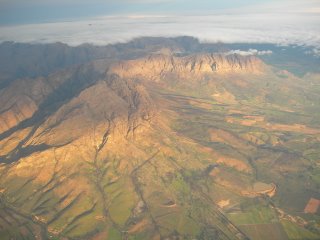
This pic is taken about 18h00, two hours after the first picture. It shows the mountains about 60km north of Cape Town. Compare the great visibility through the atmosphere with the first picture.
Eish, Im glad to live in Cape Town.
05 September, 2006
GEF Assembly 7 ...
The C.A.P.E. publication, Fynbos Fynmense – people making biodiversity work, was launched at the Cullinan Hotel in Cape Town on the 28th of August 2006. The event, which was held together with the 2006 EnviroMedia Conference, was well attended. Attendees included the Western Cape Provincial MEC for Environment, Planning and Economic Development, Tasneem Essop, as well as representatives from the World Bank, United Nations Development Programme and the Critical Ecosystems Partnership Fund.
The book is a culmination of the efforts of members of the C.A.P.E. Coordination Unit, Ally Ashwell and Sandra Turck and is the fourth volume of the SANBI Biodiversity Series. It illustrates the results of the C.A.P.E. partnership and provides examples of creative thinking in promoting biodiversity conservation in the context of sustainable development. It is hoped that the book will contribute to the dissemination of lessons learned from the C.A.P.E. Programme to other bioregional programmes.
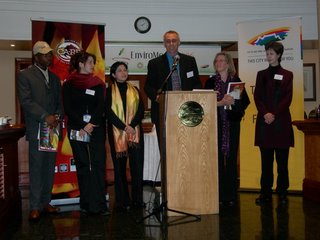
Trevor Sandwith, co-ordinator of the programme at the podium, Ally Ashwell on his left (holding a copy of the book) the primary editor and others on the editorial team.
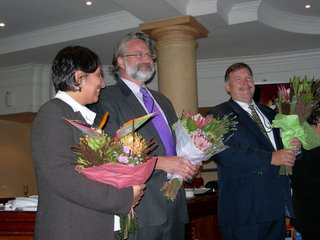
Minister Tasneem Essop (W Cape Prov Minister for Economic Affairs and Environment), and others receiving boquets after the book launch.
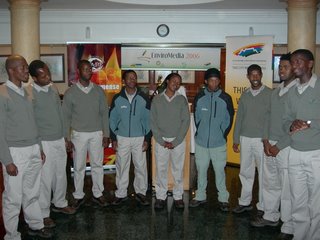
The Hoerikwaggo Table Mountain Trail Guides telling their moving story - see here for details.
They were all previously unemployed persons who were given a chance of a lifetime and seem to have grasped the opportunity with both hands.
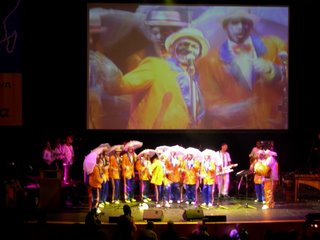
Cape minstrels taking part in the opening ceremony. In my oppinion this ceremony was kitch in the extreme and exposed among the poorest cultural offerings Cape Town had to offer! But then I'm no expert in that field.

Formalities of the opening ceremony. Left to right, W Cape Premier Ebrahim Rasool, National Environment and Tourism Minister, Martinus van Schalkwyk, National Deputy President, Phumzile Mlambo-Ngcuka and GEF CEO, Monique Barbut.
04 September, 2006
GEF Assembly 6 ...
When and if I get an evening free I'll post some of my own photographs of the event.
I also spent the weekend up the west coast with Nicolle Glineur of GEF and have lots of lovely photos of spring flowers.
International Day for Biological Diversity Theme - 22 May 2007 ...
See here for details.

Spring flowers in the Bidou Valley, east of Clanwilliam, over the Pakhuis Pass through the Cedarberg. Western Cape Province, South Africa
28 August, 2006
GEF Assembly 5 ...
Gigi and I went down early to avoid the queues

Cape Town's International Convention Centre (CTICC) where the GEF Assembly will meet and most of the side events will take place

Banner above registration.

The registration desk before the mad rush

Display of crafts in the foyer of the CTICC
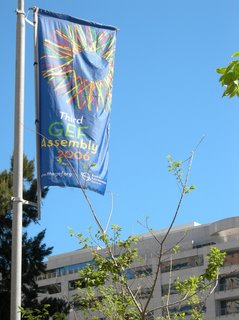
Street banner outside the CTICC - please excuse the alien invasive Cassurina/Beefwood on the left!
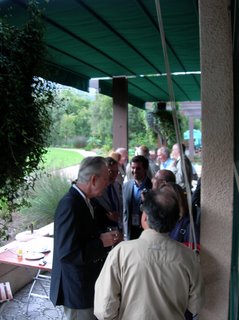
At 15h00 an informal reception was held at Kirstenbosch National Botanical Garden.
It was a warm sunny day, what we call berg (mountain) wind weather that preceedes a cold front! Tomorrow is going to be cold and rainy in the afternoon - that should surprise many of the delegates after todays perfect spring weather!
What a pitty that not a single member of our department, other than myself, attended this event. The only ones that were there were a few souls that had been roped in as volunteers, standing around handing out 'goodie' bags to the deleates. What a great opportunity to network with very influential international and and national luminaries involved in biodiversity funding. All the senior officials of the national department's international relations and biodiversity management divisions from Pretoria attended. Here we sit with two biodiversity hotspots of international significance in our province and all our .......... resists making career limiting statements .......... Ag shame - its only about biodiversity and ecosystem services!
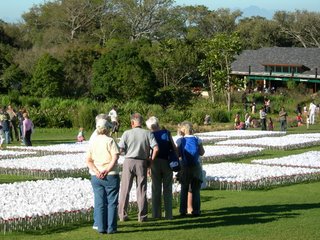
The 'Silvertree' restaurant where the reception was held.

Some of us decided to walk in the garden in the beautiful spring weather. Nicole Glineur, right, is Programme Manager: Biodiversity of the GEF and Rachael S?? is with the GEF's small grant facility in New York. That's yours truely in the middle - the grey one not the dark brown one, thank you!

William Boshoff's 'Garden of Words III' - On the lawn above the visitor centre a local South African artist, Willem Boshoff, had put up an extremely interesting atistic installation. You can read all about it on the notice above (Click on the picture to enlarge it).
Below are a range of pictures that I took of the installation.
The installation comprises 15 000 'artificial flowers' representing 15 000 endangered species and has been set up in Kirstenbosch National Botanical Garden to bring to the attention of the visitors the plight of the worlds plant biodiversity.

The inspiration comes from the fields of gravestones at Flanders

The red cups represent poppies

The folded handkerchiefs represent sadness and as well as forming petals when pressed into the 'poppies'


Willem posing in front of his installation with Nursery Buttress behind.

The words are species names and localities of endangered plants. You can't really read them, folded as they are into the 'poppies'. This represents the fading of the species. Soon they will just be memories. Eventually they'll be forgotten!
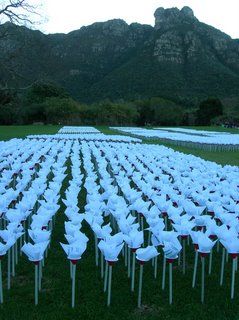
I'm extremely tempted to nip into the garden late one evening and add an extra row of poppies with certain selected names of my own.

Willem Boshoff, the artist discussing his installation with a couple of visitors to Kirstenbosch
GEF Assembly 4 ...
27 August, 2006
GEF Assembly 3 ...
The function was held at Gugu's appartment in Camps Bay.


Gigi (SANBI, Cape Town), Nik Sekhran (UNDP, Pretoria)


Sally Nittman


Eddie Russell (UNDP, Pretoria), ?, Judy Beaumont (DEAT, Pretoria)

Merle Huntley chatting to Alan Rodgers (UNDP, Nairobi)

Judy Beaumont, ?, Gugu Agha (UNDP, Geneva)
Shame, Gugu was down with a really bad cold.
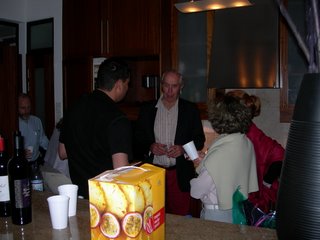
Nik Sekhran, Brian Huntley (Acting CEO, SA National Biodiversity Institute SANBI) and Nicole Glineur (GEF, Biodiversity Programme Manager, Washington)

Nik Sekhran, Kristal Maze (SANBI, Birector Biodiversity, pretoria) and Nicole Glineur

Phil Desmet and Nick ? (UNDP)

Gigi, Alex Cote (UNDP, Pretoria) and Trevor Sandwith (C.A.P.E., Cape Town)
GEF Assembly 2 ...
23 August, 2006
Biofuels workshop - 15 September ...
For programme, registration forms etc contact:
Wessel Lemmer
> Agricultural Economist
> Department of Agriculture: Western Cape
> Private Bag X1,
> Elsenburg,
> 7607,
> South Africa
> * Tel: + 27 21 808 5193
> * Cell: + 27 21 (0)82 907 3396
> * Fax: + 27 21 808 5210
> * E-mail: wessell@elsenburg.com
> * Web: www.elsenburg.com
22 August, 2006
Directorate Srategic Environmental Management, Strategic Planning Session ...

Mark Gordon addressing the Directorate: Strategic Environmental Management at our Strat Planning meeting.
The placing of this photo on this blog was a demo to Mark that the quickest way for him or the Minister to see what is going on at a site of environmental damage or illegal activity was for someone in the area to photograph the activity and blog it using cell phone connection to the internet. The pics would then be instantly available to anyone who had access to the internet.
Oh, the marvels of instant communication.
I had this picture up within 15 minutes of him quering the issue during the strat planning session!
09 August, 2006
Shutdown of Prudhoe Bay Oilfield - BP, Alaska ...
For more information see Google News links to stories about the incident.
You can see lots of pictures of the incident here.
07 August, 2006
Revision of Table Mountain National Park Management Plan ...
The three documents (Park management Plan, Conservation Development Framework and Tokai-Cecilia Management Framework) are all interrelated management tools that will guide the management of the Park into the future.
Open days, with a focus on Tokai-Cecilia, will be held for the purpose of presenting these draft documents for public comment:
Date: Monday 14th and Tuesday 15th August 2006 Time: 14h00 to 19h00
Tokai-Cecilia Workshops: 17:00 on both days
Venue: The Main Hall, Chrysalis Academy, Porter School, Tokai
For further information please contact:
Park Management Plan:
Mike Slayen (michaels@sanparks.org)
Chad Cheney (chadc@sanparks.org)
Table Mountain National Park
Tel: 021 – 701 8692
Fax: 021 701 8773
Conservation Development Framework:
Rod Cronwright (rodc@setplan.co.za)
iKapa Enviroplan
Tel: 021-422-1946
Fax: 021-424-3490
Tokai-Cecilia Management Framework:
Sarien Lategan (sarien@geostratics.co.za )
Geostratics CC: Town Planners, Environmental consultants, Research
Tel. 021-8510078
Fax 021-8520966
03 August, 2006
Suggestions for improving vehicle fuel economy ...
– Dennis Laidler
As an environmentalist, particularly concerned with climate change, I must admit to ‘getting off’ on minimising my vehicle’s fuel consumption rather than ‘voet in die hoek’ or aggressive driving. Fortunately or unfortunately I spent my formative driving years during the era of extremely severe fuel rationing in the then Rhodesia and later during the South African fuel restrictions of the late 1970’s. As a university student I remember driving a Volkswagen beetle regularly between the then Salisbury and Cape Town at a very strict 80km per hour - whew! Unfortunately the backgrounds to both of these fuel shortages were political. However, today we have other reasons prompting us to pay attention to our vehicle’s fuel consumption. Firstly, every vehicle user should take the issue of minimising their personal contribution to global carbon emissions seriously. Secondly it’s cost. The recent increase in fuel price affects almost every vehicle user, and in my humble opinion we are not going see hydrocarbon fuel prices decrease in future.
This all said, I’ve compiled the following suggestions for saving fuel, minimising your personal carbon emissions and saving you money. To supplement my own thoughts on the issue I did some research on the Internet, including the United States Environmental Protection Agency and other sites, and was reminded of many tips that had not immediately come to mind. I can’t, of course, claim that any of these ideas are unique or new and I’m sure you are aware of some of them already.
Having two sons that relatively recently obtained their driving licences caused me to refocus on the quality of my own driving style. I have now come to regard my driving time as ‘quiet quality time’ rather than ‘stress time’. As a positive side effect I have found that focusing on minimising my fuel consumption on every trip, even commuting to work, has taken a lot of the aggression out of my driving style.
I hope that you find the suggestions below useful and that they prompt you to reduce your fuel usage and modify your driving style.
Fuel saving suggestions:
1. Plan your trips – the easiest way to save fuel is not to drive your vehicle! If you have to drive plan your vehicle use and try to do as many chores on a single trip as possible. Use a bicycle or your two legs for short trips.
2. If you have to drive take the shortest and/or least traffic congested route possible – the less time you are on the road or idling the engine while going nowhere the better.
3. Don’t idle your car’s engine for more than 1 minute - If you need to idle your vehicle’s engine for a while, just turn the engine off. Contrary to popular belief, having to restart your car isn't worse for your fuel economy if you're going to idle for longer than 1 minute. Don’t use the drive through at your local burger joint. Park your vehicle and turn off the engine!
4. Use your right foot as lightly as possible on the accelerator – The greatest fuel waster while driving is rapid acceleration. From a standstill or when rolling, accelerate GENTLY up to your desired speed and change up to the next higher gear as soon as reasonably possible. Always use the highest reasonable gear for your speed. Generally speaking, the lower the engine revs the more fuel efficiently it is running.
5. If your vehicle has one, display your vehicle’s trip fuel consumption meter every time you drive and you’ll be surprised at the positive impact it has on your driving style and fuel consumption.
6. Use your right foot as lightly as possible on the brakes – If you have to apply the brakes hard at any time while you’re driving, then you are not using your powers of anticipation and your vehicle is wasting fuel. Applying the brakes hard merely converts all that expensively fuelled momentum into heating your car’s brake disks. What a waste! Keep an eye well ahead while you are driving and take your foot off the accelerator AS SOON as it appears that you may have to slow down or stop. Rather apply the brakes gently, and coast slowly up to the obstruction. The traffic lights will turn green again or the obstruction may clear and you can continue without having to waste fuel accelerating from a standstill.
7. Load your vehicle as lightly as possible – Every kilo of weight in your vehicle has to be accelerated and decelerated every time you use your right foot so don’t carry around any unnecessary load.
8. Check your tyre pressures regularly – If your tyres are under-inflated, your vehicle has to work that much harder to spin the wheels. The friction caused by these soft tyres could be significantly increasing your fuel consumption. Not to mention the premature tread wear that will cost you serious money sooner rather than later. If you’d like to test this for yourself just try cycling a bicycle with under inflated tyres compared to one with correctly inflated tyres.
9. Have your vehicle’s wheel alignment checked regularly – Poor wheel alignment not only wears your vehicles tires unnecessarily but adds extra rolling resistance to your vehicle, unnecessarily increasing fuel consumption.
10. Reduce wind resistance – Do you ever go on a long trip and stack luggage on the roof of your vehicle? These bulky items can increase your fuel consumption by up to 5%. Instead of putting your bags straight onto the roof rack, try using an aerodynamic roof box for storage. Hard aerodynamic hard roof box models offer a sleek shaped storage bin that keeps wind resistance to a minimum. You can reduce fuel consumption by completely removing the box and roof rack from your vehicle when you don't need to use it. Even though they are aerodynamic, these roof boxes are only completely drag-proof when they're off the vehicle.
11. Truck/Bakkie/LDV owners – Adding a hard or soft tonneau cover over the load bay of your truck prevents airflow against the tailgate that will give you an immediate 5% to 10% improvement in fuel consumption, to say nothing of the extra security.
12. Have your vehicle serviced and tuned regularly in accordance with the manufacturers directions – The better tuned and lubricated your vehicles engine the better your fuel consumption will be.
13. Use your air conditioner as little as possible – your car’s air conditioner can increase your vehicle’s fuel consumption as much as 10%. Rather open the car windows a little for ventilation, especially at low speeds.
14. On the other hand don’t drive fast with your car windows wide open unnecessarily – open windows will increase your car’s drag, especially at high speed, and increase fuel consumption.
15. Don’t free-wheel downhill with the vehicle out of gear – This urban legend is a popular fuel saver myth. Not only is this ineffective at saving fuel, but it is extremely dangerous. There's no reason to cut-off your acceleration control – coasting with your foot off the accelerator uses the same amount of fuel. And, letting your vehicle free-wheel downhill can generate dangerous speeds.
16. It doesn’t make financial sense to sell your current vehicle merely to replace it with a more fuel economic one – The money saved through fuel economy will not compensate for the cost of the new vehicle. It’s expensive in both money and energy to make and to buy a new vehicle. But when the time comes to replace an old vehicle, you can get a very large reduction in your fuel bill by making an informed choice. Choose a small fuel-efficient vehicle rather than the typical South African ‘pocket rocket’! Luckily in this day and age this doesn’t mean having to forgo quality or luxury. My wife and I have recently replaced her city commuter with a Fiat Panda, European car of the year 2004, 2005 and 2006. Surprisingly this modern fuel-efficient 1200cc (4.6 litres/100km or 50 miles/gallon) vehicle is even available in two 4x4 versions if that is your ‘hot button’!
17. Diesel vehicles are generally 20% more economical than a similar petrol powered vehicle – Diesel should always be the first choice for anyone concerned with fuel economy. Modern diesel engines are also much more powerful and cleaner than those of 10 or 20 years ago but they are more expensive to make so you need to decide if the extra purchase price would be covered by the fuel savings. I found this not to be the case in South Africa for the vehicles in the price range I was considering.
02 August, 2006
Third Global Environment Facility (GEF) Assembly in Cape Town ...
All the relevant information is at the Assembly's Website
The most interesting document I have discovered is the Scientific and Technical Advisory Panel (STAP) Report on the Broad Scientific and Technical Issues that emerged during the Preceding Phase of the GEF and on Emerging Issus and Gaps
The GEF home page is http://www.thegef.org/
Champion Trees Project ...
The Department of Water Affairs and Forestry (DWAF) initiated a project to identify and protect trees worthy of special protection throughout South Africa. Such projects have been established in several countries, but this is the first of its kind in Africa. Champion trees are trees of exceptional importance that deserves national protection because of their remarkable size, age, aesthetic, cultural, historic or tourism value.
I see there is also info on protected trees here and you can download the latest list of protected trees here as a pdf file.

